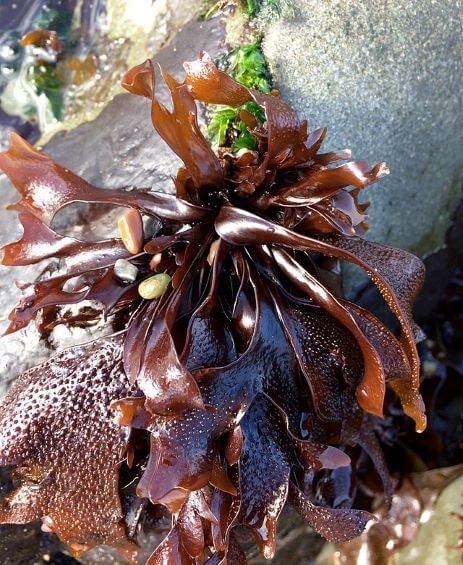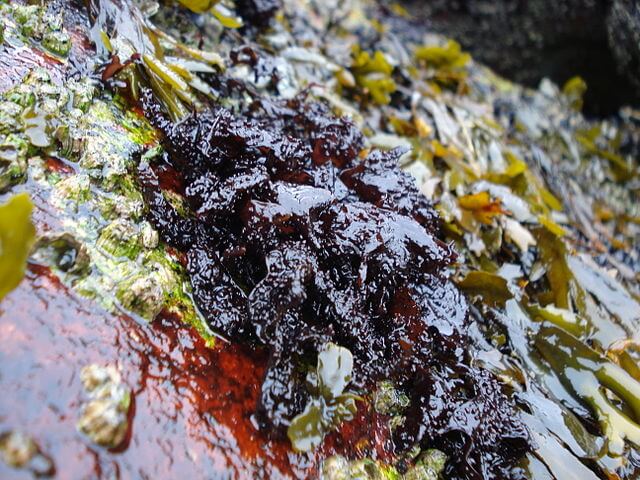Mastocarpus papillatus, or Turkish Washcloth, is an edible alga that gets its name from its bumpy surface, as the scientist who discovered this undersea delight was reminded of the special washcloths found in Turkish baths. Foragers on America’s west coast will find this seaweed growing in abundance, especially in the colder waters of the Pacific Northwest. Luckily for foragers further down the coast, Turkish washcloth grows in warmer waters as well and can be found as far south as mid-South America.

Sometimes called black tar spot, this alga earns its nickname due its deep, dark red hue. It appears dark rusty brown in the light but can take on a tar-like appearance in the dark. The females of this species are distinct because their blades are covered in a bumpy, almost sandpapery texture. The male’s blades are smooth, and so it is suggested to harvest the female species in foraging to assist with proper identification. Turkish washcloth is a short, bushy alga, with branching blades only reaching around six inches in length. You’ll find it growing most in the high to mid-tide zones, attached to rocky substrates.
Edibility and Culinary Use
Like many seaweeds, Turkish washcloth contains a lot of gelatin, making it useful as a thickener in soups and stews. It is tough and rubbery in texture when raw, but the seaweed can tenderize when fried. As a sea alga, it absorbs salt from its habitat and contains high amounts of sodium, which makes it an excellent addition to bland foods. Turkish washcloth is a popular additive to stir fries, where the quick frying results in a more tender meal.
Medicinal Uses of Turkish Washcloth
Scientific studies show that Turkish washcloth exemplifies promising antimicrobial properties. The alga is undergoing significant experimentation, as it has been shown to slow the growth of reproduction and viruses—some even as deadly as HIV. While we do not yet know what Turkish washcloth’s medical future will hold, scientists are eagerly trying to discover if it can be used to fight or cure modern illnesses.

Cautions
It is wise to use caution when foraging for Turkish washcloth to avoid confusing it with similar, and potentially inedible, algae. Beware of the larger seaweed Chondracanthus exasperates, aka Turkish towel. As this seaweed’s name suggests, this alga has a similar texture to Turkish washcloth but usually grows a much larger, single blade that forms into a cone shape. While extracts from Turkish towel are frequently used in food-grade products and for skin therapies, the alga is inedible itself. Another common cause of confusion is the narrow Turkish washcloth, Mastocarpus jardinii, which is mostly discernable by its slender blades. There is currently little research to support the edibility or inedibility of this close cousin of Turkish washcloth, so careful identification should be practiced to ensure you are foraging for the correct seaweed. As always, practice conscientious foraging by harvesting only a few blades from each algae so that it may regenerate.
Conclusion
Turkish washcloth is a readily available alga with a distinct texture, making it a prize for coastal foragers. A potential medical powerhouse, this seaweed is undergoing extensive studies, but it is also excellent for use in the home kitchen. Whether you want to thicken and salt a stew or slice it up into a stir fry, Turkish washcloth makes a savory addition to many meals. Use caution when foraging for this alga, as it can be confused with a few other species with questionable edibility. If your foraging efforts bring you across a bed of Turkish washcloth, make sure to take the time to savor its rich and unique texture.
Many of our readers find that subscribing to Eat The Planet is the best way to make sure they don't miss any of our valuable information about wild edibles.
See our privacy policy for more information about ads on this site







One Response
What makes Turkish towel not edible as it also is able to make gelatin and other food products?